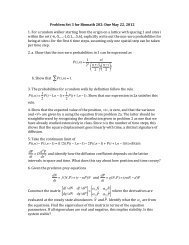J. Fluid Mech. (1998) - UCLA Department of Biomathematics
J. Fluid Mech. (1998) - UCLA Department of Biomathematics
J. Fluid Mech. (1998) - UCLA Department of Biomathematics
Create successful ePaper yourself
Turn your PDF publications into a flip-book with our unique Google optimized e-Paper software.
Band structure <strong>of</strong> surface flexural–gravity waves 347An interesting correspondence exists for gravity waves (uniform interface) in thepresence <strong>of</strong> periodic bottom scatterers. The shallow water depth-averaged equation∂t 2 η(r) =g∇ ⊥·(h(r)∇ ⊥ )η(r) (3.1)is isomorphic to the acoustic wave equations in a fluid (no shear modulus). However,although complete acoustic band gaps have been found in square latticegeometries by Sigalas & Economu (1992), (3.1) actually corresponds to uniformcompressive moduli, but different material densities in the fluid acoustic scatteringcontext. In other words, the speed <strong>of</strong> sound and the density difference are constrainedsuch that (c 1 /c 2 ) 2 = ρ 2 /ρ 1 for the analogy with (3.1) to hold. Under theseconditions, Sigalas & Economu (1992) find no complete band gaps. Therefore, weconclude that the periodic-bottom shallow water wave problem has no complete bandgaps.4. Summary and conclusionsIn this paper, we have presented a simple way <strong>of</strong> analysing the dispersion relationfor surface flexural–gravity waves in the presence <strong>of</strong> periodic flexible surfacescatterers. A generalization <strong>of</strong> Bloch’s Theorem in a system with periodic boundaryoperators is established. The method is adapted from established techniques foundin Ashcr<strong>of</strong>t & Mermin (1976), Joannopoulos et al. (1995), and Sigalas & Economu(1992) for calculating multiple scattering in electronic, optical, and acoustic phenomena.Figures 2–8 encapsulate the main conclusions. The exact numerical calculationsimplicitly included all evanescent modes. We have treated the most computationallydifficult case, that <strong>of</strong> sharp surface discontinuities, and conclude: (i) band gaps canexist in flexural surface scattering <strong>of</strong> monochromatic waves; (ii) the band gaps canincrease with excitation frequency ω, at higher order; (iii) the sensitivity to depth isweak for k x h 0.5 (1D); (iv) the sensitivity to f and D 1 /D 2 can be strong; (v) certainspecial values <strong>of</strong> f and D 1 /D 2 have vanishing gaps and (vi) the high dispersion in thissystem prevents the formation <strong>of</strong> complete band gaps in the two-dimensional case.The gaps discussed here are associated with non-propagating waves and correspondto the ‘fully resonant’ scattering from a finite number <strong>of</strong> periodic bottom undulationsdiscussed in Davies et al. (1989) where their analyses broke down. Further exploitingthe acoustic analogy, we also conclude that complete band gaps do not appear inperiodic-bottom shallow water wave scattering.Our description <strong>of</strong> band gaps, frequencies where water waves cease to propagate,implies possible structures for wave damping applications such as breakwaters. Withina large field <strong>of</strong> periodically spaced flexible plates, the band gaps determine thestanding wave response, and reflect all travelling waves from the large field <strong>of</strong>plates. If a structure embedded in this field is susceptible to lateral wave forces, thenit may be desirable to have large band gaps where waves are standing. Periodicsurface scatterers can also function as wave frequency filters. The important result(v) above suggests that band gaps are generally not monotonic in f and D 2 /D 1and there are special values <strong>of</strong> these parameters which can be targeted or avoideddepending on the application. Although it appears that no simple complete gapsexist for periodically bottom or surface scattered waves (due to a large dispersionin the surface scattering case, and due to uniform gravity in the shallow bottomscattering case), by appropriately choosing the two-dimensional surface periodicityrelative to mean wind directions say, one may nonetheless shunt propagating wavesfor desired band gap frequencies. The effects <strong>of</strong> directionality <strong>of</strong> externally impinging




